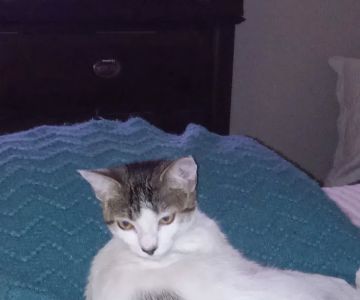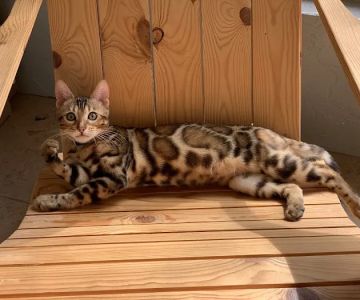- 1 - Understanding-How-Arthritis-Develops-in-Senior-Cats
- 2 - Subtle-Behavioral-Signs-That-Could-Indicate-Cat-Arthritis
- 3 - Physical-Symptoms-and-Mobility-Changes-in-Arthritic-Cats
- 4 - Case-Study-Muffin's-Story-of-Living-with-Arthritis
- 5 - Diagnosing-Arthritis-Why-Professional-Assessment-Matters
- 6 - Ways-to-Help-Your-Cat-Manage-Arthritis-Symptoms
- 7 - Lifestyle-Adjustments-and-Home-Support-for-Arthritic-Cats
1. Understanding How Arthritis Develops in Senior Cats
Arthritis, or osteoarthritis, is a degenerative joint disease that affects many senior cats but often goes undiagnosed. As cats age, the cartilage cushioning their joints can wear down, leading to pain, inflammation, and reduced mobility. Unlike dogs, cats tend to mask discomfort, making it harder for owners to recognize the problem. According to the American Association of Feline Practitioners, over 90% of cats over 12 years old show signs of arthritis on x-rays, yet only a small percentage receive treatment. This disconnect is often due to a lack of awareness. Recognizing the early signs of arthritis in older cats can significantly improve quality of life when addressed early.
2. Subtle Behavioral Signs That Could Indicate Cat Arthritis
Many early arthritis symptoms in older cats appear behavioral rather than physical. Owners may notice their cat becoming less active, avoiding heights, or seeming irritable during petting. Changes like sleeping in lower spots, hesitating before jumping, or reduced grooming could all suggest joint discomfort. Some cats may even begin avoiding the litter box if stepping into it becomes painful. These signs are easy to dismiss as "just getting old," but they are often early indicators of joint degeneration. Paying attention to these subtle shifts is critical in catching arthritis before it severely limits your cat's life. If you're unsure, Hidden Brook Veterinary can help assess these behaviors and suggest early interventions.
3. Physical Symptoms and Mobility Changes in Arthritic Cats
As arthritis progresses, physical symptoms become more obvious. You might observe stiffness when your cat stands up after a nap or limping during walks around the house. Some cats may lick or chew at affected joints, which can lead to hair loss in localized areas. Swollen joints, decreased muscle mass in the hind legs, and a hunched posture are also common physical signs of arthritis in older cats. These changes don’t happen overnight, but when they do appear, they significantly affect your cat's comfort and independence. If your cat avoids movement or seems more reluctant to play, don’t wait—professional assessment is essential.
4. Case Study: Muffin’s Story of Living with Arthritis
Muffin, a 13-year-old tabby from North Carolina, had always been an active climber. Her owners noticed she stopped jumping onto the windowsill, opting to stay on the floor instead. At first, they thought she was simply slowing down with age. But when she began to miss the litter box and growled when touched near her hind legs, they brought her to Hidden Brook Veterinary. A full exam revealed moderate arthritis in both knees. With pain medication, joint supplements, and a few home modifications, Muffin regained her comfort. Her story is a reminder: arthritis doesn’t have to steal your cat’s spirit. The right care can restore joy and mobility, even in older pets.
5. Diagnosing Arthritis: Why Professional Assessment Matters
While owners can spot changes, only a licensed veterinarian can confirm a diagnosis of feline arthritis. A full evaluation often includes a physical exam, joint palpation, and x-rays. In some cases, advanced imaging like MRI may be used. Vets also assess your cat’s weight, muscle tone, and gait. Diagnosing arthritis early allows for better pain control and slows down degeneration. Don’t rely on guesswork or online advice—bring your senior cat to a clinic like Hidden Brook Veterinary where feline-specific exams are designed to detect subtle joint issues. Early diagnosis leads to better outcomes, better mobility, and fewer days spent in pain.
6. Ways to Help Your Cat Manage Arthritis Symptoms
Once diagnosed, managing cat arthritis includes a multi-faceted approach. Pain relief is often provided through medications like NSAIDs or gabapentin, depending on the severity. Supplements such as glucosamine and omega-3 fatty acids may support joint health. Weight control is vital—excess pounds put strain on aging joints. Acupuncture, laser therapy, and physical rehabilitation can also offer relief for some cats. Always work closely with your vet before beginning any treatment. At Hidden Brook Veterinary, we create personalized arthritis care plans tailored to your cat's specific needs and health history. Every step matters when it comes to easing the discomfort of feline arthritis.
7. Lifestyle Adjustments and Home Support for Arthritic Cats
Creating an arthritis-friendly home can make a world of difference for your senior cat. Consider using ramps or steps to help them access favorite spots. Provide soft bedding in accessible areas to reduce pressure on joints. Use low-entry litter boxes and non-slip mats around feeding stations. Heating pads or orthopedic cat beds can offer added comfort during colder months. Keep playtime gentle but consistent to maintain muscle tone. Remember, arthritis isn’t a death sentence—it’s a manageable condition. With the right environmental changes and support, your cat can continue to live a full, happy life. For more ideas and supplies, Hidden Brook Veterinary offers a range of arthritis-friendly products suited for aging cats.











